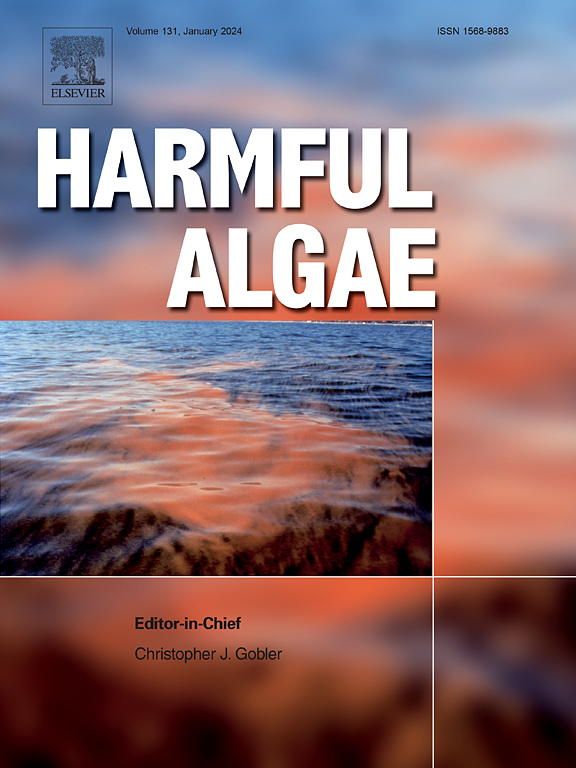长达十年的亚得里亚海(地中海)西北部贻贝有害鞭毛藻繁殖和生物毒素污染研究
IF 4.5
1区 生物学
Q1 MARINE & FRESHWATER BIOLOGY
引用次数: 0
摘要
亚得里亚海西北部是地中海富营养化程度最高的地区之一,也是重要的水产养殖区,约占意大利贝类产量的90%。自20世纪70年代以来,该地区频繁发生有害藻华,对消费者和沿海生态系统构成了威胁。尽管欧洲立法要求对浮游植物进行定期监测,但整合浮游植物种类分类分析、相关生物毒素和环境数据的长期研究仍然有限。本研究分析了来自艾米利亚-罗马涅地区海岸的11年数据集(2012-2022),重点研究了与贝类毒性相关的有毒鞭毛藻的时间和发生趋势。分析了养殖贻贝中的浮游植物种类分布和生物毒素含量,特别注意了类似物的存在。2012 - 2015年,最常见的毒素为yessotoxins (YTXs,高达8.44 mg kg-1),主要是同质ytx和45OH同质ytx,与gonyaululax spinifera和Lingulaulax polydra秋季开花有关。从2015年开始,冈田酸及其衍生物(OAs,高达941µg kg-1)成为最普遍的藻毒素群,与秋季出现的fortii和acuminata恐龙有关。这种时间变化可能是由于地表水温度和盐度的增加,这有助于减少水柱混合,有利于少营养物种。值得注意的是,尽管产生YTXs的物种丰度下降,但贻贝中YTXs的水平仍然很低。此外,即使在双壳类动物中不含石蜡毒素(STXs)的情况下,也始终检测到Alexandrium spsp .的细胞。这些发现强调了对菌株特异性毒性、藻毒素在双壳类动物中的积累和野外监测进行综合研究的必要性。本文章由计算机程序翻译,如有差异,请以英文原文为准。
A decade-long study on harmful dinoflagellate blooms and biotoxin contamination in mussels from the north-western Adriatic Sea (Mediterranean Sea)
The north-western Adriatic Sea is one of the most eutrophic areas of the Mediterranean Sea and an important aquaculture region, accounting for about 90% of Italian shellfish production. Since the 1970s, this area has experienced frequent harmful algal blooms, posing risks to consumers and coastal ecosystems. Despite the regular monitoring required by European legislation, long-term studies integrating taxonomic analysis of phytoplankton species, associated biotoxins, and environmental data remain limited. This study examines an 11-year dataset (2012–2022) from the Emilia-Romagna region coast, focusing on timing and occurrence trends of toxic dinoflagellates related to the shellfish toxicity. Phytoplankton species distribution and biotoxins content in farmed mussels were analysed, with particular attention to the presence of analogues. From 2012 to 2015, the most prevalent toxins were yessotoxins (YTXs, up to 8.44 mg kg-1), primarily homo-YTX and 45OH homo-YTX, which were associated with autumn blooms of Gonyaulax spinifera and Lingulaulax polyedra. From 2015, okadaic acids and derivatives (OAs, up to 941 µg kg-1) became the most prevalent phycotoxin group, associated to Dinophysis fortii and Dinophysis acuminata presence during autumn. This temporal shift was likely driven by increasing surface water temperature and salinity, which contributed to reduced water column mixing favouring oligotrophic species. Notably, low levels of YTXs persisted in mussels despite decreased abundances of producing species. Additionally, Alexandrium spp. cells were consistently detected, even in the absence of saxitoxins (STXs) in bivalves. These findings highlighted the need for integrated studies on strain-specific toxicity, phycotoxins accumulation in bivalves, and field monitoring.
求助全文
通过发布文献求助,成功后即可免费获取论文全文。
去求助
来源期刊

Harmful Algae
生物-海洋与淡水生物学
CiteScore
12.50
自引率
15.20%
发文量
122
审稿时长
7.5 months
期刊介绍:
This journal provides a forum to promote knowledge of harmful microalgae and macroalgae, including cyanobacteria, as well as monitoring, management and control of these organisms.
 求助内容:
求助内容: 应助结果提醒方式:
应助结果提醒方式:


